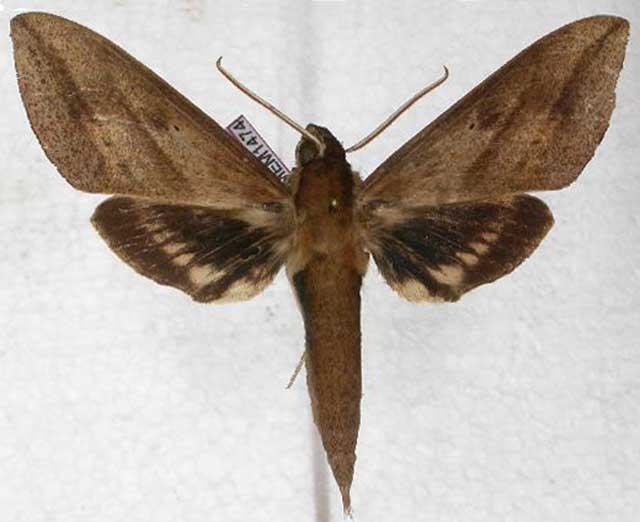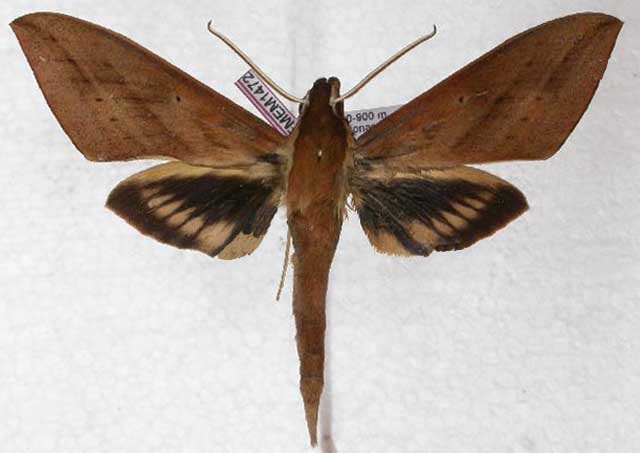Xylophanes porioni
|
|
Updated as per http://sphingidae.myspecies.info/taxonomy/term/5698; March 16, 2017
Sphingidae Museum, Czech Republic
|
Xylophanes porioni
Zah-lah-FAN-neesM
POUR-ee-on-eye
Cadiou, 2000

Xylophanes porioni female, 79mm, Peru,
courtesy of Ulf Eitschberger.
This site has been created by Bill Oehlke. Comments, suggestions and/or additional information are welcomed by Bill.
TAXONOMY:
Family: Sphingidae, Latreille, 1802
Subfamily: Macroglossinae, Harris, 1839
Tribe: Macroglossini, Harris, 1839
Genus: Xylophanes Hubner [1819] ...........
Species: porioni Cadiou, 2000
|
DISTRIBUTION:
Xylophanes porioni
[wingspan 78-79-88mm // forewing length: males: 39-40mm] flies in
Peru: Amazonas: road from Bagua to Moyobamba, about 30km after Pomacochas, Aguas Verdes, at elevation near 800-1600m.
Wikipedia: "It is distinguishable from all other Xylophanes species by the combination of the broad, compact shape of the wings, the suffused brown pattern of the
forewing upperside and the arrangement of spots forming the median band of the hindwing upperside. The ground colour of the upperside of the body and forewings is
reddish brown. The forewing upperside is similar in general appearance to that of Xylophanes rufescens, but the pattern of lines and spots is more
contrasting. The first postmedian line is diffuse, running to the costa rather than the apex. The second and third postmedian lines are weakly developed,
also running to the costa and below the fourth postmedian line it is replaced by vein dots, or it is represented only by a row of vein dots.
The median band of the hindwing upperside consists of a series of off-white triangular spots that increase in size from the apex towards the anal angle."

Xylophanes porioni female, 79mm, Peru,
courtesy of Sphingidae Museum Czech Republic.

Xylophanes porioni female, 79mm, Peru,
900m, courtesy of Ulf Eitschberger.
FLIGHT TIMES:
Xylophanes porioni adults probably have at least two flights annually. The specimen typ was colected in February 2000.
ECLOSION:
Pupae probably wiggle to surface from subterranean chambers or leaf litter just prior to eclosion.
SCENTING AND MATING:Females call in the males with a pheromone released from a gland at the tip of the abdomen.
EGGS, LARVAE, PUPAE:
The pronunciation of scientific names is troublesome for many. The "suggestion" at the top of the page is merely a suggestion. It is based on
commonly accepted English pronunciation of Greek names and/or some fairly well accepted "rules" for latinized scientific names.
The suggested pronunciations, on this page and on other pages, are primarily put forward to assist those who hear with internal ears as they read.
There are many collectors from different countries whose intonations and accents would be different.
Jean Marie Cadiou writes, "When I say "Xylophanes" in English I pronounce it something like "Zailophanees", with the emphasis on the
"o". The French pronounce it differently, something like "Kzeelophaness" with no emphasis, and the Germans yet in a different way..."
In Greek myth, Phanes is the golden winged Primordial Being who was hatched from the shining Cosmic Egg that was the source of the
universe. He personifies light emerging from chaos.
"Xylo" is the Greek word for wood.
The specimen type for the genus Xylophanes is Xylophanes anubus. Perhaps ? when Hubner
examined that species, the yellow-orange and brown tones of the forewings suggested wings of wood.
The species name "porioni" is honourific for Porion.
Use your browser "Back" button to return to the previous page.
Goto Main Sphingidae Index
Goto Macroglossini Tribe
Goto Central American Indices
Goto Carribean Islands
Goto South American Indices
Goto U.S.A. tables


